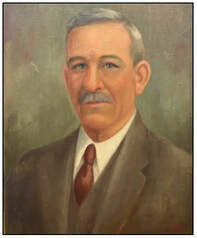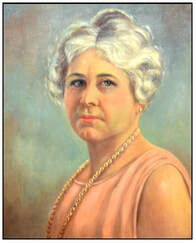Library Made Possible with Gift from Killgore Foundation
When the new courthouse was opened August of 1931, no arrangements had been made for a county library.
Noel McDade became county judge in 1934 and designated a small room in the courthouse as a library. Some shelves were installed in the "bareboned" little room and some basic equipment, but few books were added.
Mrs. Ethel Klock was serving as volunteer librarian. She and a library committee went to the commissioners' court in April of 1938 to request some funding. Commissioners were Lew Haile, George Bain, W. W. Burnett and Clyde Messenger.
The depression was still on and the county budget was tight. The commissioners agreed to provide the location, utilities, $1 day for a librarian, and $5 a month for books. Mrs. Klock served as librarian until 1941. Other librarians were Mrs. Rowena Roberts, Mrs. Dorothy Hastings, Miss Mary Ellis Blackburn, (a member of the library committee who kept the library open during World War II), Mrs. W. C. Mowery, Mrs. J. H. Perdue, Mrs. Doris Jones, Mrs. Mary Alice Henthorn, Phoebe Strother, Helen Wooley, Joe Weaver, Angela Wakefield and Deborah Skinner.
Noel McDade became county judge in 1934 and designated a small room in the courthouse as a library. Some shelves were installed in the "bareboned" little room and some basic equipment, but few books were added.
Mrs. Ethel Klock was serving as volunteer librarian. She and a library committee went to the commissioners' court in April of 1938 to request some funding. Commissioners were Lew Haile, George Bain, W. W. Burnett and Clyde Messenger.
The depression was still on and the county budget was tight. The commissioners agreed to provide the location, utilities, $1 day for a librarian, and $5 a month for books. Mrs. Klock served as librarian until 1941. Other librarians were Mrs. Rowena Roberts, Mrs. Dorothy Hastings, Miss Mary Ellis Blackburn, (a member of the library committee who kept the library open during World War II), Mrs. W. C. Mowery, Mrs. J. H. Perdue, Mrs. Doris Jones, Mrs. Mary Alice Henthorn, Phoebe Strother, Helen Wooley, Joe Weaver, Angela Wakefield and Deborah Skinner.
Library space in the courthouse was increased in 1955, more money was allotted for books and supplies and an assistant librarian was hired. In 1959, bookmobile services were started. The bookmobile was a car where books were made available to Cactus, Natural Gas Pipeline Camp, Exell Helium Plant, Middlewell and the Bivins Plant.
The City of Dumas began helping with the expanded library service.
A one-fourth block area at the southeast corner of East Second and South Bliss Avenue was purchased for $15,000 in 1960. Architects Rittenberry, Rittenberry and Associates had plans for a 6,600 square foot building complete by November. Bids were to be received by December 12.
A grant of $100,000 from the Killgore Foundation financed the project.
A county wide drive was started with a goal of $15,000 to purchase books. A door to door canvas by member of over 20 organizations was conducted and $13,000 was raised. "Each One Buy One" was the motto.
The new library was named Killgore Memorial Library in honor of the couple who made it possible, Charles and Florence Killgore. It was dedicated on July 23, 1961.
The City of Dumas began helping with the expanded library service.
A one-fourth block area at the southeast corner of East Second and South Bliss Avenue was purchased for $15,000 in 1960. Architects Rittenberry, Rittenberry and Associates had plans for a 6,600 square foot building complete by November. Bids were to be received by December 12.
A grant of $100,000 from the Killgore Foundation financed the project.
A county wide drive was started with a goal of $15,000 to purchase books. A door to door canvas by member of over 20 organizations was conducted and $13,000 was raised. "Each One Buy One" was the motto.
The new library was named Killgore Memorial Library in honor of the couple who made it possible, Charles and Florence Killgore. It was dedicated on July 23, 1961.
|
Charles was born in October of 1871 in Kentucky. Florence was born in October of 1873 in Missouri. She came to the Panhandle with her parents, Mr. and Mrs. Garnet Lee, by covered wagon in 1891. They homesteaded on land east of the present Canadian River Bridge. The first bridge over the Canadian River was named after her -- The Florence Lee Bridge.
Charles and Florence were married July 23, 1907, and made their home in Amarillo, but spent summers at their ranch, Circle Bar, in the Middlewell Community. They had two children, one died in infancy and a son died of diphtheria when he was about seven. They had no other heirs. At the time of Charles' death, they had extensive farming, ranching and gas interests in Moore County and New Mexico. Florence died August 2, 1955 at age 81. She was given credit for the vast growth of the Killgore holdings and at the time of her death, the entire estate of $2 million was left to charitable organizations. She wrote a number of poems through the years and published a book of poems with this forward: "I do not make a profession of writing, but these little verses have come to me through the years and seem to express what I felt at the time..." The book was dedicated "to my fine husband, Charles Lewis Killgore." |



